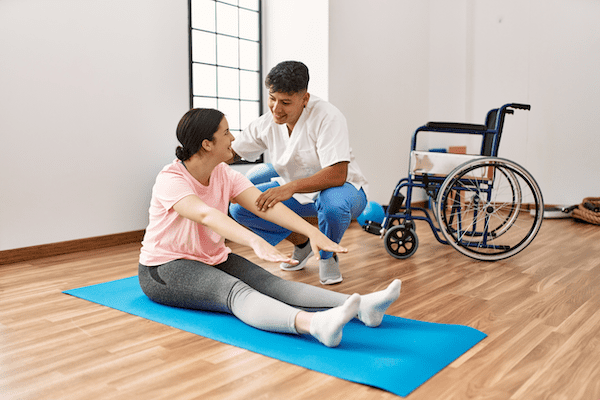Physical therapy yoga often focuses on therapeutic perks and achieving improved posture. These practices may prove beneficial if you want to reduce discomfort or enhance your functional movement. The following movements are commonly used in this type of yoga:
Mountain Pose
To begin the mountain pose, stand with your feet together and let your big toes touch each other. This position helps distribute your weight evenly and works to improve your posture while sitting or standing. To engage the muscles in your legs, squeeze your inner thighs together and hold the muscles tight.
At this stage, lift the crown of your head toward the ceiling while keeping the chin parallel to the floor. This stance also helps stretch out your spine and relieve any discomfort that you may be experiencing in your back. To calm your entire body, roll your shoulders back and down, allowing your arms to hang at your sides.
Cat-cow Pose
This physical therapy yoga posture involves alternating between cat and cow poses to encourage flexibility in the spine. Cat-cow pose also has a strong emphasis on controlled inhaling and exhaling. To achieve this position, gently settle on your hands and knees with your palms under your shoulders. If you want to increase comfort and alignment during the pose, spread your fingers and flatten your back.
As you breathe out, curl your back up like a cat, pulling your belly button in toward your spine, and tuck your chin toward your chest. While breathing in, lower your belly to the floor as you bring the top of your head and tailbone up toward the ceiling. Repeat the two parts of the pose as you continue to inhale and exhale.
Bridge Pose
Bridge pose is a reliable exercise for strengthening your back, buttocks, and leg muscles, which can improve everyday physical support. Since it also stretches the chest, neck, and spine, it may help lower tension and improve flexibility in those areas. To begin the bridge pose, lie on your back, bend your knees, and keep your feet flat on the floor.
To open your hips and add a focus on core strengthening, inhale and lift your hips while your back and shoulders remain on the floor. You can place your hands at your sides with palms placed firmly on the floor for increased stabilization. For more of a challenge and potential benefits from this position, hold the pose for a few breaths before lowering your hips back to the floor as you let out your breath.
Legs-up-the-wall Pose
This yoga position aims to relieve tension in the hamstrings and calves by stretching them. For the legs-up-the-wall pose, sit down with your tailbone close to the wall, lie back in a controlled manner, and place the length of your legs to rest up against the wall. If possible, try to keep your legs straight to achieve a deeper stretch.
You can place your arms at your sides for more support as you breathe in and out slowly. This position can ease lower back soreness and stretch your inner thighs, helping you become more flexible in your hip joints.
Corpse Pose
After an intense workout, the corpse posture can help the body recuperate by easing tense muscles and relaxation. Using a yoga mat or a comfortable surface, lie on your back and straighten your legs on the floor. To help you decrease tension in your shoulders and upper body, place your arms at your sides with your palms facing up. Positioning your arms in this way distributes some of your body weight and helps you maintain good posture. At this point, you can breathe in and out slowly to assist in releasing retained anxiety.
Register for Physical Therapy Yoga Classes
Therapeutic yoga includes several poses that address discomfort in the body and improve strength and flexibility. To help calm the body and mind, these motions also involve deep breathing. If you want to experience the benefits of physical therapy yoga, sign up for classes today.

